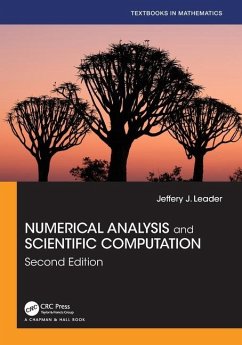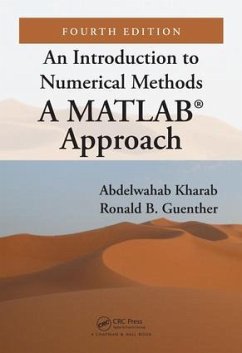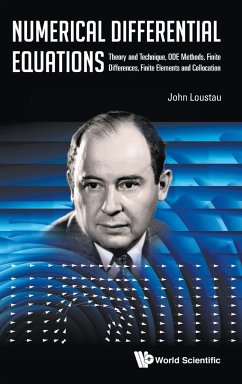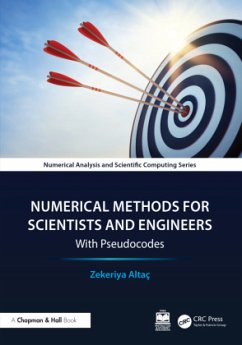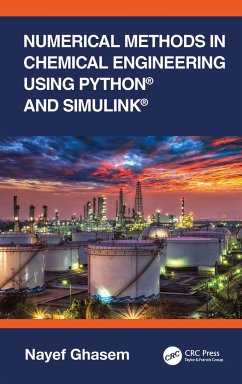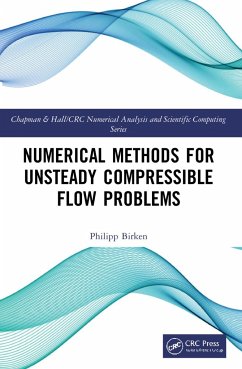
Numerical Analysis
Pearson New International Edition
Versandkostenfrei!
Versandfertig in 2-4 Wochen
123,99 €
inkl. MwSt.
Weitere Ausgaben:

PAYBACK Punkte
62 °P sammeln!
Numerical Analysis, Second Edition, is a modern and readable text for the undergraduate audience. This book covers not only the standard topics but also some more advanced numerical methods being used by computational scientists and engineers—topics such as compression, forward and backward error analysis, and iterative methods of solving equations—all while maintaining a level of discussion appropriate for undergraduates. Each chapter contains a Reality Check, which is an extended exploration of relevant application areas that can launch individual or team projects. MATLAB® is used throughout to demonstrate and implement numerical methods. The Second Edition features many noteworthy improvements based on feedback from users, such as new coverage of Cholesky factorization, GMRES methods, and nonlinear PDEs. Features + Benefits
Chapter 0 (optional) provides students with the fundamental building blocks they will need in later chapters. The entire text is designed to move from elementary ideas to more sophisticated concepts to avoid sudden jumps in level.
Spotlights throughout the text highlight the five major ideas of numerical analysis—convergence, complexity, conditioning, compression, and orthogonality. These spotlights comment on the topic at hand and make informal connections to other expressions of the same concept elsewhere in the book, helping students synthesize new material with what they already know.
Reality Checks appear in each chapter to provide extended examples of the way numerical methods lead to solutions of important technological problems, making the topics immediately relevant.
MATLAB® expositions appear throughout the text, giving students and instructors guidance on using this important software tool.
Appendix B is a short MATLAB tutorial that can be used as a first introduction to students who have not used MATLAB, or as a reference to students already familiar with the software.
The Companion website contains MATLAB projects taken directly from the text.
Preface
0. Fundamentals
0.1 Evaluating a polynomial
0.2 Binary numbers
0.2.1 Decimal to binary
0.2.2 Binary to decimal
0.3 Floating point representation of real numbers
0.3.1 Floating point formats
0.3.2 Machine representation
0.3.3 Addition of floating point numbers
0.4 Loss of significance
0.5 Review of calculus
0.6 Software and Further Reading
1. Solving Equations
1.1 The Bisection Method
1.1.1 Bracketing a root
1.1.2 How accurate and how fast?
1.2 Fixed point iteration
1.2.1 Fixed points of a function
1.2.2 Geometry of Fixed Point Iteration
1.2.3 Linear Convergence of Fixed Point Iteration
1.2.4 Stopping criteria
1.3 Limits of accuracy
1.3.1 Forward and backward error
1.3.2 The Wilkinson polynomial
1.3.3 Sensitivity and error magnification
1.4 Newton’s Method
1.4.1 Quadratic convergence of Newton's method
1.4.2 Linear convergence of Newton's method
1.5 Root-finding without derivatives
1.5.1 Secant method and variants
1.5.2 Brent's Method
REALITY CHECK 1: Kinematics of the Stewart platform
1.6 Software and Further Reading
2. Systems of Equations
2.1 Gaussian elimination
2.1.1 Naive Gaussian elimination
2.1.2 Operation counts
2.2 The LU factorization
2.2.1 Backsolving with the LU factorization
2.2.2 Complexity of the LU factorization
2.3 Sources of error
2.3.1 Error magnification and condition number
2.3.2 Swamping
2.4 The PA=LU factorization
2.4.1 Partial pivoting
2.4.2 Permutation matrices
2.4.3 PA = LU factorization
REALITY CHECK 2: The Euler-Bernoulli Beam
2.5 Iterative methods
2.5.1 Jacobi Method
2.5.2 Gauss-Seidel Method and SOR
2.5.3 Convergence of iterative methods
2.5.4 Sparse matrix computations
2.6 Methods for symmetric positive-definite matrices
2.6.1 Symmetric positive-definite matrices
2.6.2 Cholesky factorization
2.6.3 Conjugate Gradient Method
2.6.4 Preconditioning
2.7 Nonlinear systems of equations
2.7.1 Multivariate Newton's method
2.7.2 Broyden's method
2.8 Software and Further Reading
3. Interpolation
3.1 Data and interpolating functions
3.1.1 Lagrange interpolation
3.1.2 Newton's divided differences
3.1.3 How many degree d polynomials pass through n points?
3.1.4 Code for interpolation
3.1.5 Representing functions by approximating polynomials
3.2 Interpolation error
3.2.1 Interpolation error formula
3.2.2 Proof of Newton form and error formula
3.2.3 Runge phenomenon
3.3 Chebyshev interpolation
3.3.1 Chebyshev's Theorem
3.3.2 Chebyshev polynomials
3.3.3 Change of interval
3.4 Cubic splines
3.4.1 Properties of splines
3.4.2 Endpoint conditions
3.5 Bézier curves
REALITY CHECK 3: Constructing fonts from Bézier splines
3.6 Software and Further Reading
4. Least Squares
4.1 Least squares and the normal equations
4.1.1 Inconsistent systems of equations
4.1.2 Fitting models to data
4.2 Linear and nonlinear models
4.1.3 Conditioning of least squares
4.2 A survey of models
4.2.1 Periodic data
4.2.2 Data linearization
4.3 QR factorization
4.3.1 Gram-Schmidt orthogonalization and least squares
4.3.2 Modified Gram-Schmidt orthogonalization
4.3.3 Householder reflectors
4.4 Generalized Minimum Residual (GMRES) Method
4.4.1 Krylov methods
4.4.2 Preconditioned GMRES
4.5 Nonlinear least squares
4.5.1 Gauss-Newton method
4.5.2 Models with nonlinear parameters
4.5.3 Levenberg-Marquardt method
REALITY CHECK 4: GPS, conditioning and nonlinear least squares
4.6 Software and Further Reading
5. Numerical Differentiation and Integration
5.1 Numerical differentiation
5.1.1 Finite difference formulas
5.1.2 Rounding error
5.1.3 Extrapolation
5.1.4 Symbolic differentiation and integration
5.2 Newton-Cotes formulas for numerical integration
5.2.1 Trapezoid rule
5.2.2 Simpson's Rule
5.2.3 Composite Newton-Cotes Formulas
5.2.4 Open Newton-Cotes methods
5.3 Romberg integration
5.4 Adaptive quadrature
5.5 Gaussian quadrature
REALITY CHECK 5: Motion control in computer-aided modelling
5.6 Software and Further Reading
6. Ordinary Differential Equations
6.1 Initial value problems
6.1.1 Euler's method
6.1.2 Existence, uniqueness, and continuity for solutions
6.1.3 First-order linear equations
6.2 Analysis of IVP solvers
6.2.1 Local and global truncation error
6.2.2 The explicit trapezoid method
6.2.3 Taylor methods
6.3 Systems of ordinary differential equations
6.3.1 Higher order equations
6.3.2 Computer simulation: The pendulum
6.3.3 Computer simulation: Orbital mechanics
6.4 Runge-Kutta methods and applications
6.4.1 The Runge-Kutta family
6.4.2 Computer simulation: The Hodgkin-Huxley neuron
6.4.3 Computer simulation: The Lorenz equations
REALITY CHECK 6: The Tacoma Narrows Bridge
6.5 Variable step-size methods
6.5.1 Embedded Runge-Kutta pairs
6.5.2 Order 4/5 methods
6.6 Implicit methods and stiff equations
6.7 Multistep methods
6.7.1 Generating multistep methods
6.7.2 Explicit multistep methods
6.7.3 Implicit multistep methods
6.8 Software and Further Reading
7. Boundary Value Problems
7.1 Shooting method
7.1.1 Solutions of boundary value problems
7.1.2 Shooting method implementation
REALITY CHECK 7: Buckling of a circular ring
7.2 Finite difference methods
7.2.1 Linear boundary value problems
7.2.2 Nonlinear boundary value problems
7.3 Collocation and the Finite Element Method
7.3.1 Collocation
7.3.2 Finite elements and the Galerkin method
7.4 Software and Further Reading
8. Partial Differential Equations
8.1 Parabolic equations
8.1.1 Forward difference method
8.1.2 Stability analysis of forward difference method
8.1.3 Backward difference method
8.1.4 Crank-Nicolson method
8.2 Hyperbolic equations
8.2.1 The wave equation<
Chapter 0 (optional) provides students with the fundamental building blocks they will need in later chapters. The entire text is designed to move from elementary ideas to more sophisticated concepts to avoid sudden jumps in level.
Spotlights throughout the text highlight the five major ideas of numerical analysis—convergence, complexity, conditioning, compression, and orthogonality. These spotlights comment on the topic at hand and make informal connections to other expressions of the same concept elsewhere in the book, helping students synthesize new material with what they already know.
Reality Checks appear in each chapter to provide extended examples of the way numerical methods lead to solutions of important technological problems, making the topics immediately relevant.
MATLAB® expositions appear throughout the text, giving students and instructors guidance on using this important software tool.
Appendix B is a short MATLAB tutorial that can be used as a first introduction to students who have not used MATLAB, or as a reference to students already familiar with the software.
The Companion website contains MATLAB projects taken directly from the text.
Preface
0. Fundamentals
0.1 Evaluating a polynomial
0.2 Binary numbers
0.2.1 Decimal to binary
0.2.2 Binary to decimal
0.3 Floating point representation of real numbers
0.3.1 Floating point formats
0.3.2 Machine representation
0.3.3 Addition of floating point numbers
0.4 Loss of significance
0.5 Review of calculus
0.6 Software and Further Reading
1. Solving Equations
1.1 The Bisection Method
1.1.1 Bracketing a root
1.1.2 How accurate and how fast?
1.2 Fixed point iteration
1.2.1 Fixed points of a function
1.2.2 Geometry of Fixed Point Iteration
1.2.3 Linear Convergence of Fixed Point Iteration
1.2.4 Stopping criteria
1.3 Limits of accuracy
1.3.1 Forward and backward error
1.3.2 The Wilkinson polynomial
1.3.3 Sensitivity and error magnification
1.4 Newton’s Method
1.4.1 Quadratic convergence of Newton's method
1.4.2 Linear convergence of Newton's method
1.5 Root-finding without derivatives
1.5.1 Secant method and variants
1.5.2 Brent's Method
REALITY CHECK 1: Kinematics of the Stewart platform
1.6 Software and Further Reading
2. Systems of Equations
2.1 Gaussian elimination
2.1.1 Naive Gaussian elimination
2.1.2 Operation counts
2.2 The LU factorization
2.2.1 Backsolving with the LU factorization
2.2.2 Complexity of the LU factorization
2.3 Sources of error
2.3.1 Error magnification and condition number
2.3.2 Swamping
2.4 The PA=LU factorization
2.4.1 Partial pivoting
2.4.2 Permutation matrices
2.4.3 PA = LU factorization
REALITY CHECK 2: The Euler-Bernoulli Beam
2.5 Iterative methods
2.5.1 Jacobi Method
2.5.2 Gauss-Seidel Method and SOR
2.5.3 Convergence of iterative methods
2.5.4 Sparse matrix computations
2.6 Methods for symmetric positive-definite matrices
2.6.1 Symmetric positive-definite matrices
2.6.2 Cholesky factorization
2.6.3 Conjugate Gradient Method
2.6.4 Preconditioning
2.7 Nonlinear systems of equations
2.7.1 Multivariate Newton's method
2.7.2 Broyden's method
2.8 Software and Further Reading
3. Interpolation
3.1 Data and interpolating functions
3.1.1 Lagrange interpolation
3.1.2 Newton's divided differences
3.1.3 How many degree d polynomials pass through n points?
3.1.4 Code for interpolation
3.1.5 Representing functions by approximating polynomials
3.2 Interpolation error
3.2.1 Interpolation error formula
3.2.2 Proof of Newton form and error formula
3.2.3 Runge phenomenon
3.3 Chebyshev interpolation
3.3.1 Chebyshev's Theorem
3.3.2 Chebyshev polynomials
3.3.3 Change of interval
3.4 Cubic splines
3.4.1 Properties of splines
3.4.2 Endpoint conditions
3.5 Bézier curves
REALITY CHECK 3: Constructing fonts from Bézier splines
3.6 Software and Further Reading
4. Least Squares
4.1 Least squares and the normal equations
4.1.1 Inconsistent systems of equations
4.1.2 Fitting models to data
4.2 Linear and nonlinear models
4.1.3 Conditioning of least squares
4.2 A survey of models
4.2.1 Periodic data
4.2.2 Data linearization
4.3 QR factorization
4.3.1 Gram-Schmidt orthogonalization and least squares
4.3.2 Modified Gram-Schmidt orthogonalization
4.3.3 Householder reflectors
4.4 Generalized Minimum Residual (GMRES) Method
4.4.1 Krylov methods
4.4.2 Preconditioned GMRES
4.5 Nonlinear least squares
4.5.1 Gauss-Newton method
4.5.2 Models with nonlinear parameters
4.5.3 Levenberg-Marquardt method
REALITY CHECK 4: GPS, conditioning and nonlinear least squares
4.6 Software and Further Reading
5. Numerical Differentiation and Integration
5.1 Numerical differentiation
5.1.1 Finite difference formulas
5.1.2 Rounding error
5.1.3 Extrapolation
5.1.4 Symbolic differentiation and integration
5.2 Newton-Cotes formulas for numerical integration
5.2.1 Trapezoid rule
5.2.2 Simpson's Rule
5.2.3 Composite Newton-Cotes Formulas
5.2.4 Open Newton-Cotes methods
5.3 Romberg integration
5.4 Adaptive quadrature
5.5 Gaussian quadrature
REALITY CHECK 5: Motion control in computer-aided modelling
5.6 Software and Further Reading
6. Ordinary Differential Equations
6.1 Initial value problems
6.1.1 Euler's method
6.1.2 Existence, uniqueness, and continuity for solutions
6.1.3 First-order linear equations
6.2 Analysis of IVP solvers
6.2.1 Local and global truncation error
6.2.2 The explicit trapezoid method
6.2.3 Taylor methods
6.3 Systems of ordinary differential equations
6.3.1 Higher order equations
6.3.2 Computer simulation: The pendulum
6.3.3 Computer simulation: Orbital mechanics
6.4 Runge-Kutta methods and applications
6.4.1 The Runge-Kutta family
6.4.2 Computer simulation: The Hodgkin-Huxley neuron
6.4.3 Computer simulation: The Lorenz equations
REALITY CHECK 6: The Tacoma Narrows Bridge
6.5 Variable step-size methods
6.5.1 Embedded Runge-Kutta pairs
6.5.2 Order 4/5 methods
6.6 Implicit methods and stiff equations
6.7 Multistep methods
6.7.1 Generating multistep methods
6.7.2 Explicit multistep methods
6.7.3 Implicit multistep methods
6.8 Software and Further Reading
7. Boundary Value Problems
7.1 Shooting method
7.1.1 Solutions of boundary value problems
7.1.2 Shooting method implementation
REALITY CHECK 7: Buckling of a circular ring
7.2 Finite difference methods
7.2.1 Linear boundary value problems
7.2.2 Nonlinear boundary value problems
7.3 Collocation and the Finite Element Method
7.3.1 Collocation
7.3.2 Finite elements and the Galerkin method
7.4 Software and Further Reading
8. Partial Differential Equations
8.1 Parabolic equations
8.1.1 Forward difference method
8.1.2 Stability analysis of forward difference method
8.1.3 Backward difference method
8.1.4 Crank-Nicolson method
8.2 Hyperbolic equations
8.2.1 The wave equation<
Numerical Analysis, Second Edition, is a modern and readable text for the undergraduate audience. This book covers not only the standard topics but also some more advanced numerical methods being used by computational scientists and engineers?topics such as compression, forward and backward error analysis, and iterative methods of solving equations?all while maintaining a level of discussion appropriate for undergraduates. Each chapter contains a Reality Check, which is an extended exploration of relevant application areas that can launch individual or team projects. MATLAB® is used throughout to demonstrate and implement numerical methods. The Second Edition features many noteworthy improvements based on feedback from users, such as new coverage of Cholesky factorization, GMRES methods, and nonlinear PDEs.
Dieser Artikel kann nur an eine deutsche Lieferadresse ausgeliefert werden.






